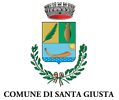DISCOVER ROMANESQUE: Glossary
ABCDFGHILMNPRSTVW
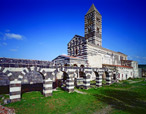
Abbey
Abbey

A monastic community which is independent of episcopal authority. A complex consisting of an abbey church and the buildings required for monastic life.
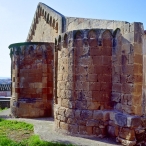
Apse
Apse

The semicircular structure generally positioned at the eastern end of a church.

Apsidal conch
Apsidal conch
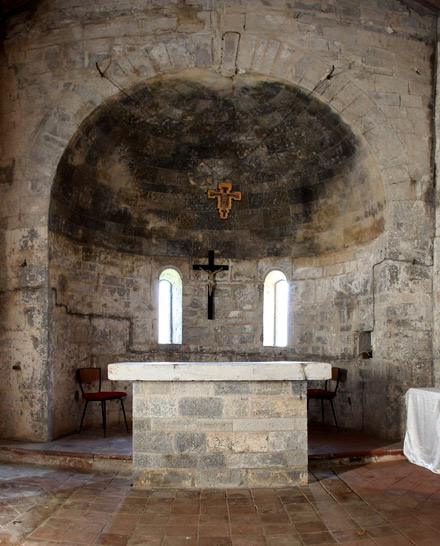
A half cap covering the apsidal half cylinder.

Arch (round, pointed, horseshoe)
Arch (round, pointed, horseshoe)

A curved structure having a supporting and decorative function and resting on columns, pillars or jambs. A round arch is semicircular in shape; the curve of a pointed arch is broken centrally at the top to form a cusp; a horseshoe arch is shaped so that the centre of the circumference is on a higher level than the diameter.
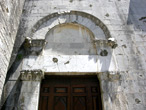
Architrave
Architrave

An architectural element resting or fitted horizontally on top of two supporting elements, enclosing a quadrangular space and supporting any weight.

Archivolt
Archivolt

A decorative band skirting the front of an arch.

Ashlar
Ashlar

A building stone squared and smoothed on the exposed surface.

Barrel vault
Barrel vault

A roof covering consisting of a half cylinder resting on two perimeter walls.
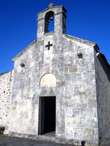
Bell gable
Bell gable

A masonry structure generally built on the facade and pierced by openings in which the church bell are hung.

Blind arch
Blind arch
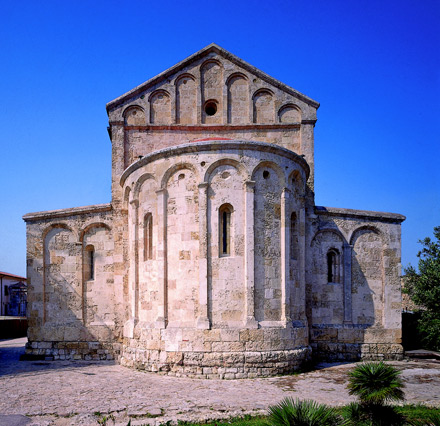
An arch projecting from a wall and resting on pilasters or half columns. As a rule, it is one of a series and fulfils a decorative function.
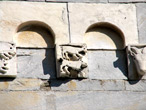
Bracket
Bracket

A small corbel designed to support hanging archlets or masonry arches, sometimes enclosing various subjects sculpted in relief.

Capital
Capital
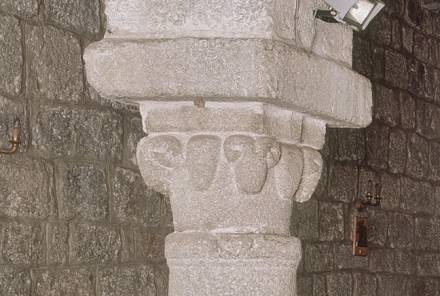
A truncated-cone-shaped stone element topping a column and supporting an arch or architrave.
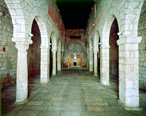
Cathedral
Cathedral

The main church in a diocese where the bishop performs his functions. A cathedra, or bishop's throne, stood behind or next to the high altar.
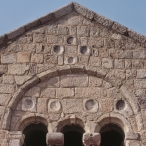
Ceramic basin
Ceramic basin

A glazed painted earthenware bowl in the form of a hemisphere, frequently used as a wall decoration in mosques and Romanesque churches.

Client
Client

A person or organization (secular or ecclesiastical) that promotes and finances a work of art.

Column/Pillar
Column/Pillar

A vertical supporting architectural element with a circular cross-section, generally consisting of a base, a shaft and a capital. If the shaft is non-circular in cross-section, the element is generally termed a pillar.

Condaghe
Condaghe

A document formerly used in Sardinia to bequeath a legacy or donation to a church. The term is also used in a wider sense to denote a book recording the deeds relating to a medieval monastery in Sardinia.
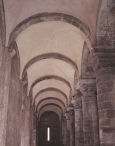
Cross vault
Cross vault

A roof covering formed by the intersection at right angles of two barrel vaults.
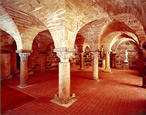
Crypt
Crypt

A vaulted space, partly or totally underground, lying below the floor of a church and frequently housing the bodies and relics of saints.
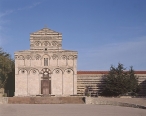
Dichromatic masonry
Dichromatic masonry

Building work consisting of stones of different colours (generally light-coloured limestone and dark-coloured volcanic stone) alternating in a more or less regular fashion.

Diocese
Diocese

An ecclesiastical district placed under the authority of a bishop.

Dome
Dome

A cap-shaped vault with perfect central symmetry. It can have a polygonal, circular or elliptical base and a semicircular, parabolic or ovoid profile.

Fake loggia
Fake loggia

A series of mural archlets giving the impression of a walkable arcade.
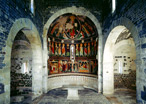
Fresco
Fresco

A painting technique involving the application of watered-down colours on fresh plaster.

Gable
Gable

A triangular space above the trabeation which is bound by two slopes.

Giudicato
Giudicato

One of the four Sardinian kingdoms (Cagliari, Arborea, Gallura, Torres) ruled by a judge or king following the naming used in Sardinia between the 11th and 15th centuries.
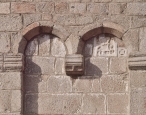
Hanging arch
Hanging arch

A decorative element resting on consoles or corbels and running along the top of church walls.

Impost
Impost

The surface supporting an arch on top of a column or pillar.

Intarsia
Intarsia

An ornamental technique that fits together small pieces of different materials to form a predetermined pattern. In Upper Tyrrhenian Romanesque, the inlaying of shaped pieces in a concave marble base, used for floors and decorative panels.

Labour
Labour

Workers employed in a building yard with different skills – architects, stonecutters, masons, sculptors, painters.

Lunette
Lunette

The semicircular surface between the architrave of a doorway and the arch above.

Main body
Main body

The space in a church that is accessible to the faithful, as distinct from the presbytery, the area reserved for the clergy.
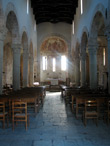
Nave/Aisles
Nave/Aisles

A longitudinal section in a church (or part thereof) bounded by columns or pillars, 'nave' being the term applied to the central section and 'aisles' the word used for the side spaces.
Part of the interior of a church that is separated from the remainder by a row of columns or pillars.

Pieve
Pieve

A rural church with a baptistery, located at the centre of a civil and religious district. Originally used to denote a rural district in a diocese, the term came to indicate the head church of the district, which was entitled to administer baptism and bury the dead on behalf of the bishop.

Pilaster
Pilaster

A vertical element of a wall, consisting of a half pillar or a half column.

Plan (T-shaped, longitudinal, Latin-cross, aisleless)
Plan (T-shaped, longitudinal, Latin-cross, aisleless)

A schematic (reduced-scale) representation of the spaces that form a building.
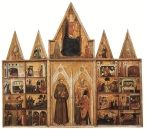
Polyptych
Polyptych

A painting on wood or canvas consisting of several parts joined by a fixed frame or hinges.
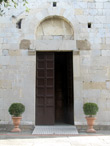
Portal
Portal

The entrance to a civil or religious building, characterized by a more or less elaborate structure and architectural decoration.

Predella
Predella

A painted band divided into several panel, usually forming the lower portion of altar-pieces painted on wood.

Presbytery
Presbytery

The part of a church that surrounds the high altar and is reserved for the clergy. It is generally separated from the main body of the church by one or more steps or by a fence.
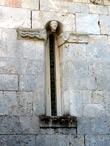
Protome
Protome

A decorative element in the form of a head or bust of a human being, an animal, a monster or of an animal with a human head. It is used to adorn consoles, cornices and pediments.
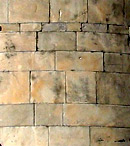
Pseudo-isodomic technique
Pseudo-isodomic technique

A building technique using well-squared slabs which are laid alternately flat and upright. Unlike the isodomic technique, it does not correspond to the full thickness of the wall.
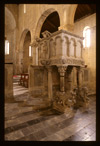
Pulpit
Pulpit

A liturgical structure in the church consisting of a wooden or stone box, generally supported by columns and accessed via steps. It was formerly used by priests when reading the holy scriptures.

Rectory
Rectory

An institution by virtue of which the clergy of a parish gathered to organize their pastoral activity, or the place where communal life was conducted. From the mid-12th century onwards the term has also been used to denote the dwelling of the rector of a non-canonical church.
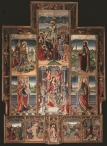
Retable
Retable

A painting placed on the altar, consisting of several wooden panels (polyptych) connected by frames. The panels are distempered, frequenlty with gold backgrounds. It was introduced to Sardinia after the Catalan-Aragonese conquest.
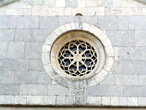
Rose window
Rose window

Generally a round window with a radiating motif, piercing the facade of a church. The term may also denote a generic motif with the same shape.

Rusticated ashlar
Rusticated ashlar

Rough-hewn building stone in the form of an irregular parallelepiped.
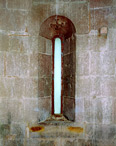
Single-light window
Single-light window

A window with a single light.

Splay
Splay

Bevel cut of the stones that form a window towards both the inside and the outside of a church. This makes it possible to maximize the quantity of light gathered from the outside, concentrate it to the centre and diffuse it towards the interior as a light beam.

Stepped lozenge
Stepped lozenge

A motif in the walls of Romanesque churches consisting of a diamond embedded in the masonry, frequently embellished with tarsia decorations.

String course
String course
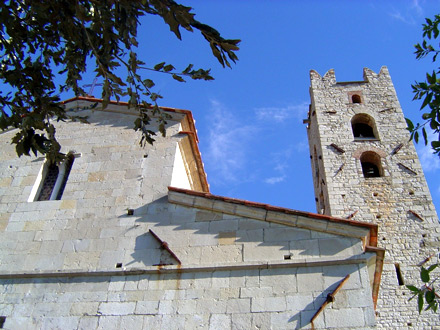
An architectural element consisting of a series of projecting mouldings, frequently decorated with bas-reliefs and designed to mark the separation between different levels of a building.

Tetramorph
Tetramorph

A representation of the Gospels and the Evangelists through their respective symbols – a man for Matthew, a lion for Mark, a bull for Luke and an eagle for John.
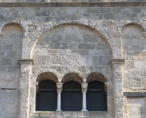
Three-light window
Three-light window

A window with three lights separated by mullions.

Tier
Tier

A horizontal section forming part of the decoration of a wall surface.

Transept
Transept

An architectural space of varying size crossing the nave and aisles at right angles.

Truss
Truss

A triangular frame of beams used as a support structure for a two-pitch roof. It is generally made of wood.

Two-light mullioned window
Two-light mullioned window

A window with two lights separated by a mullion.

Vestments and church plate
Vestments and church plate

Movable items (silver plate, books, paraments, etc.) and fixtures (pulpit, altar, presbyterial fence, etc.) used in religious ceremonies and celebrations in a church.

Wall panel
Wall panel

A vertical portion of a wall surface, generally bounded by pilasters.

Wheel
Wheel

A round, usually inlaid element decorating masonry.

Women's gallery
Women's gallery

An internal arcade facing the nave, originally meant for women.





















